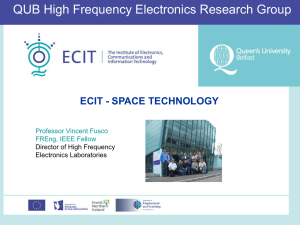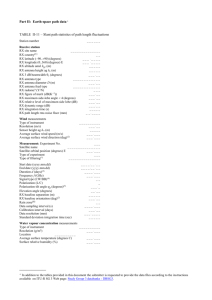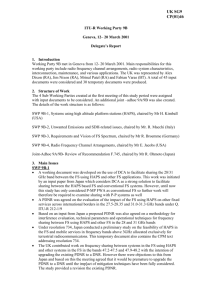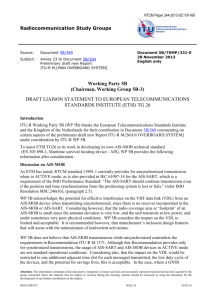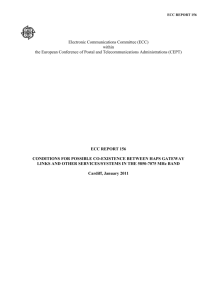Word - ITU
advertisement
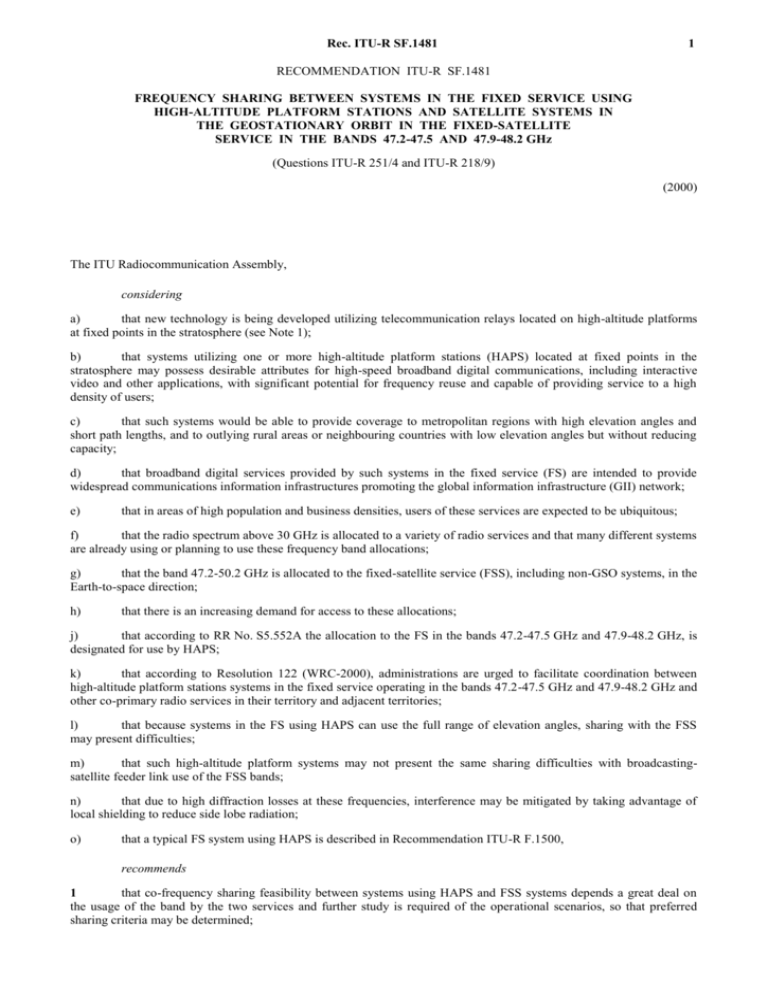
Rec. ITU-R SF.1481 1 RECOMMENDATION ITU-R SF.1481 FREQUENCY SHARING BETWEEN SYSTEMS IN THE FIXED SERVICE USING HIGH-ALTITUDE PLATFORM STATIONS AND SATELLITE SYSTEMS IN THE GEOSTATIONARY ORBIT IN THE FIXED-SATELLITE SERVICE IN THE BANDS 47.2-47.5 AND 47.9-48.2 GHz (Questions ITU-R 251/4 and ITU-R 218/9) (2000) Rec. ITU-R SF.1481 The ITU Radiocommunication Assembly, considering a) that new technology is being developed utilizing telecommunication relays located on high-altitude platforms at fixed points in the stratosphere (see Note 1); b) that systems utilizing one or more high-altitude platform stations (HAPS) located at fixed points in the stratosphere may possess desirable attributes for high-speed broadband digital communications, including interactive video and other applications, with significant potential for frequency reuse and capable of providing service to a high density of users; c) that such systems would be able to provide coverage to metropolitan regions with high elevation angles and short path lengths, and to outlying rural areas or neighbouring countries with low elevation angles but without reducing capacity; d) that broadband digital services provided by such systems in the fixed service (FS) are intended to provide widespread communications information infrastructures promoting the global information infrastructure (GII) network; e) that in areas of high population and business densities, users of these services are expected to be ubiquitous; f) that the radio spectrum above 30 GHz is allocated to a variety of radio services and that many different systems are already using or planning to use these frequency band allocations; g) that the band 47.2-50.2 GHz is allocated to the fixed-satellite service (FSS), including non-GSO systems, in the Earth-to-space direction; h) that there is an increasing demand for access to these allocations; j) that according to RR No. S5.552A the allocation to the FS in the bands 47.2-47.5 GHz and 47.9-48.2 GHz, is designated for use by HAPS; k) that according to Resolution 122 (WRC-2000), administrations are urged to facilitate coordination between high-altitude platform stations systems in the fixed service operating in the bands 47.2-47.5 GHz and 47.9-48.2 GHz and other co-primary radio services in their territory and adjacent territories; l) that because systems in the FS using HAPS can use the full range of elevation angles, sharing with the FSS may present difficulties; m) that such high-altitude platform systems may not present the same sharing difficulties with broadcastingsatellite feeder link use of the FSS bands; n) that due to high diffraction losses at these frequencies, interference may be mitigated by taking advantage of local shielding to reduce side lobe radiation; o) that a typical FS system using HAPS is described in Recommendation ITU-R F.1500, recommends 1 that co-frequency sharing feasibility between systems using HAPS and FSS systems depends a great deal on the usage of the band by the two services and further study is required of the operational scenarios, so that preferred sharing criteria may be determined; 2 Rec. ITU-R SF.1481 2 that to facilitate sharing in the bands 47.2-47.5 GHz and 47.9-48.2 GHz FSS earth stations should utilize antennas with diameters of at least 2.4 m, or other types of antenna with similar performance; 3 that, when installing user terminals or gateway stations in the FS using HAPS, or FSS earth stations, advantage should be taken of local topography or of man-made features so as to maximize the shielding of side lobe radiation while maintaining system performance. This may include locating antennas at the minimum acceptable height above ground level; 4 that in those areas where a HAPS system is intended to provide a ubiquitous service, sharing with FSS earth stations is not expected to be generally feasible. For the typical HAPS system described in Recommendation ITU-R F.1500, with symmetrical service areas around the HAPS nadir point, the limit of ubiquitous service is expected to be at the outer edge of the suburban area coverage, at about 80 km from nadir; 5 that in the rural coverage area, beyond 80 km radius, the provision of a ubiquitous service is not anticipated and sharing with FSS earth stations is feasible. The maximum separation distance, taking account of 10 dB local shielding is approximately 30 km, but this is strongly dependent on the geometries of earth stations relative to the user terminals and in many cases may be less than 1 km; 6 that in analysing the sharing feasibilities between systems in the FS using HAPS and systems in the FSS, the methodology in Annex 1 and the information in Annexes 2 and 3 be provisionally used (see Notes 2 to 5). NOTE 1 – It is recognized that systems utilizing HAPS have a potential applicability to various radio services such as mobile and broadcasting services. In this Recommendation the application is focused on the FS in the 47.2-47.5 GHz and 47.9-48.2 GHz bands. NOTE 2 – The information in Annexes 2 and 3 is for a specific system being developed. Further study is required for developing widely applicable interference criteria. NOTE 3 – Parameters for BSS feeder links cited in Annex 3 are taken from Report ITU-R BO.2016. Parameters for the GSO FSS systems used are also cited in Annex 3. NOTE 4 – There may be a need to develop the maximum allowable pfd at satellites on the GSO due to the aggregate interference caused by ground user terminals of high-altitude platform networks. NOTE 5 – The assessment of aggregate interference may be improved by developing a simulation model that takes into account geographical distributions and antenna characteristics of the ground terminals in the high-altitude platform networks. ANNEX 1 Methodology for studying frequency sharing between high-density systems in the FS using HAPS and the FSS 1 Introduction This Annex presents the interference criteria and the prediction procedures to be used for sharing analyses between highdensity systems in the FS using HAPS and FSS systems. The frequency bands considered are 47.2-47.5 GHz and 47.9-48.2 GHz. The characteristics of a typical network using HAPS for the high-density FS application are given in Recommendation ITU-R F.1500, some relevant parameters are summarized in Annex 2. Typical system parameters for GSO BSS feeder links and for GSO FSS systems are given in Annex 3. Rec. ITU-R SF.1481 2 3 Calculation procedure The e.i.r.p. density in a 1 MHz reference bandwidth can be calculated from the following formula: e.i.r. p. P Gt Ltf 10 log B dB(W/MHz) where: P: transmitter output power density (dB(W/MHz)) Gt : transmitting antenna gain (dBi) Ltf : antenna feeder loss (dB) B: bandwidth. The elements to be taken into account in estimating the total path loss are given in Recommendation ITU-R P.1409. A formula for atmospheric attenuation is also given in Recommendation ITU-R SF.1395. The expected received power density can be calculated from: Pr P Gt – Ltf Gr – Lrf – La – L p – 10 log B – 20 log (4d /) – 60 dB(W/MHz) (1) where: Pr : expected received carrier power density (dB(W/MHz)) P: transmitting output power density (dB(W/MHz)) Gt : transmitting antenna gain (dBi) Ltf : antenna feeder loss (dB) Gr : gain of the receiving antenna (dBi) Lrf : receiving antenna feeder loss (dB) La : atmospheric absorption for a particular elevation angle (dB) Lp : attenuation due to other propagation effects (dB) : wavelength (m) d: distance (km). ANNEX 2 System characteristics for a typical high-altitude platform network 1 The high-altitude platform system The description of a typical system is given in Recommendation ITU-R F.1500. The system comprises a high-altitude platform in a nominally fixed location in the stratosphere at a height of 21 to 25 km. Communication is between the platform and user terminals on the ground in a cellular arrangement permitting substantial frequency reuse. User terminals are described as being within one of three zones: urban, suburban and rural area coverages (UAC, SAC and RAC, respectively). 1.1 Coverage areas The coverage areas are defined in terms of the elevation angle at the ground to the HAPS. The depression angles at the platform are closely similar. Table 1 gives the angles and the corresponding ground coverage range measured from nadir. 4 Rec. ITU-R SF.1481 TABLE 1 Coverage zones Coverage area 1.2 Ground range (km) Elevation angles (degrees) Platform at 21 km Platform at 25 km UAC 90-30 0-36 0-43 SAC 30-15 36-76.5 43-90.5 RAC 15-5 76.5-203 90.5-234 Platform station Typical transmitter and antenna characteristics for a platform station are given in Table 2. Communications with user terminals will use time division multiplexed (TDM) 4-PSK modulation, and with gateway stations will use high-level modulation, 64-QAM. TABLE 2 Platform station transmitter parameters 1.3 Communication to Transmitter power (dBW) Antenna gain (dBi) UAC 1.3 30 SAC 1.3 30 RAC 3.5 41 Gateway (UAC) 0 35 Gateway (SAC) 9.7 38 User terminals and gateway stations The corresponding parameters for the ground stations are given in Table 3. In the up direction the user terminals will use demand assigned multicarrier TDMA with 4-PSK modulation, while gateway stations will use similar techniques to those from the platform. TABLE 3 Ground station transmitter characteristics Communication to 1.4 Transmitter power (dBW) Antenna gain (dBi)) UAC –8.2 23 SAC –7 38 RAC –1.5 38 Gateway (UAC) 1.7 46 Gateway (SAC) 13.4 46 Antenna radiation patterns The antenna radiation patterns for platform antennas conform to Recommendation ITU-R S.672. Rec. ITU-R SF.1481 5 ANNEX 3 System parameters for FSS 1 System parameters for BSS feeder links BSS feeder-link parameters Modulation 4-PSK Frequency (GHz) 48.2 Bandwidth (MHz) 1 Transmitting antenna (earth station): Power (dB(W/MHz)) 3 Gain (dBi) 57.7 Feeder loss (dB) 2.5 e.i.r.p. (dB(W/MHz)) 58.2 Elevation angle (degrees) 55 Path length (km) 36 780 Free space loss (dB) 217.4 Atmospheric absorbtion (dB) 2 1.2 System parameters of a GSO FSS Earth-to-space link Earth station Uplink frequency (GHz) 47.2-50.2 Maximum antenna gain (2.4 m/0.9 m) (dBi) 59.7/51.2 29 – 25 log min –10 Antenna gain pattern (dBi) Earth station feeder loss (dB) 2.5 Minimum elevation angle (degrees) 20 Maximum power density (2.4 m/0.9 m) (dB(W/MHz)) –1.8/6.7 Maximum e.i.r.p. density (2.4 m/0.9 m) (dB(W/MHz)) 55.4/55.4 Satellite Maximum antenna gain (dBi) 51.5 Satellite G/T (dB(K–1)) 23.4 System noise temperature (K) 650 Beam size (degrees) 0.3 Number of beams 24

